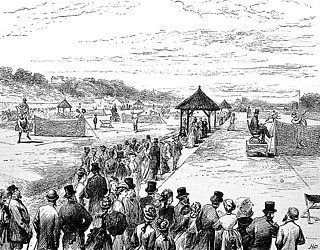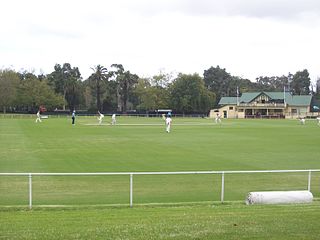
John Albert Kramer was an American tennis player of the 1940s and 1950s, and a pioneer promoter who helped drive the sport towards professionalism at the elite level. Kramer also ushered in the serve-and-volley era in tennis, a playing style with which he won three Grand Slam tournaments. He also led the U.S. Davis Cup tennis team to victory in the 1946 and 1947 Davis Cup finals.
Mary Ewing Outerbridge was an American woman who imported the lawn game tennis to the United States from Bermuda.

The County Cricket Ground, known for sponsorship reasons as The1st Central County Ground, is a cricket venue in Hove, in the city of Brighton and Hove, East Sussex, England. The County Ground is the home of Sussex County Cricket Club, where most Sussex home matches since 1872 have been played, although many other grounds in Sussex have been used. Sussex CCC continue to play some of their games away from The County Ground, at either Arundel Castle or Horsham. It is one of the few county grounds to have deckchairs for spectators, in the Sussex CCC colours of blue and white, and was the first cricket ground to install permanent floodlights, for day/night cricket matches and the second ground to host a day/night match in England, in 1997.

The Prince's Club was a socially exclusive gentlemen's multisports club in London, England. The original 'Prince's Club' was founded in 1853 in Chelsea by George and James Prince and its main sports were rackets and real tennis. Cricket, croquet and lawn tennis were also played. After most of its ground was lost to building developments it closed in 1887. Its successor, the 'New Prince's Club', located in Knightsbridge, opened in 1888 and kept its focus on rackets and real tennis, but no longer had any outdoor sports. In 1896 the Prince's Skating Club was opened. The Prince's Club was in operation until the 1940s.
The history of United States cricket begins in the 18th century. The first game was between the US and Canada and held in 1844 in front of an audience of 5,000 spectators in New York. Among early Americans, cricket was as popular a bat and ball game as baseball. Though Americans never played cricket in great numbers, the game grew for some time. Around the time of the United States Civil War, the game began competing with baseball for participants, but then slowly declined in popularity. This was followed again by a brief golden age with the Philadelphian cricket team. This lasted until roughly the start of World War I; at this time, cricket again became less popular. In the latter part of the 20th century immigrants from cricket-playing nations in South Asia and the West Indies helped spark a resurgence in the game's popularity. This led to participation and success in several International Cricket Council events. In 2007, the United States of America Cricket Association was suspended by the ICC because of problems with its administration, but was again recognized beginning in 2008.

The 1877 Wimbledon Championship was a men's tennis tournament held at the All England Croquet and Lawn Tennis Club in Wimbledon, London. It was the world's first official lawn tennis tournament, and was later recognised as the first Grand Slam tournament or "Major". The AEC & LTC had been founded in July 1868, as the All England Croquet Club. Lawn tennis was introduced in February 1875 to compensate for the waning interest in croquet. In June 1877 the club decided to organise a tennis tournament to pay for the repair of its pony roller, needed to maintain the lawns. A set of rules was drawn up for the tournament, derived from the first standardised rules of tennis issued by the Marylebone Cricket Club in May 1875.

Longwood Cricket Club is a tennis and former cricket club based in Chestnut Hill, Massachusetts, United States. It is the site of the first Davis Cup competition.

The Canadian cricket team in the United States in 1844 was a tour consisting of the first international cricket match. The match took place between 24 and 26 September 1844 at the St George's Cricket Club's ground at what is now 30th Street and Broadway in Manhattan, New York. The game was billed as 'United States of America versus the British Empire's Canadian Province’.
The Staten Island Cricket Club (SICC) is a cricket club on Staten Island, New York, United States, that was incorporated as the Staten Island Cricket and Base Ball Club on March 22, 1872. It became the first tennis venue in the United States.

Albert Cricket Ground, also known as the Albert Reserve and previously as the Warehouseman's Cricket Ground, is a cricket ground in St Kilda, Victoria. It is operated by the Melbourne Cricket Club (MCC), and used as its primary home ground in the Victorian Premier Cricket competition.
The Orange Lawn Tennis Club is the second oldest tennis club in New Jersey. Located in South Orange, it was established three years after the Seabright Lawn Tennis and Cricket Club in Rumson.
The Victorian Championships was its original name until 1968. It was a tennis event held from 1879 through 1971. It was originally played at the Melbourne Cricket Ground Lawn Tennis Club, until 1933 when the venue changed to Kooyong Lawn Tennis Club Australia for the remainder of its run.

The 1878 men's tennis season was composed of the third annual pre-open era tour. It now incorporated 15 tournaments staged in Great Britain and Ireland the Wimbledon Championships was won by challenger Patrick Francis Hadow defeating the defending champion Spencer Gore.
Juliette Atkinson won the singles tennis title by defeating reigning champion Elisabeth Moore 6–3, 6–3, 4–6, 3–6, 6–3 in the Challenge Round of the 1897 U.S. Women's National Singles Championship, reversing the result of the previous Championships. Atkinson had won the right to challenge Moore by defeating Edith Kenderdine 6–2, 6–4, 6–0 in the final of the All Comers' competition. The event was played on outdoor grass courts and held at the Philadelphia Cricket Club in Wissahickon Heights, Chestnut Hill, Philadelphia from June 15 through June 19, 1897.
Juliette Atkinson won the singles tennis title of the 1898 U.S. Women's National Singles Championship by defeating challenger Marion Jones 6–3, 5–7, 6–4, 2–6, 7–5 in the Challenge Round, surviving five matchpoints in the final set. It was Atkinon's third singles title, after 1895 and 1897, which gave her permanent ownership of the Wissahickon Inn Challenge Cup. Jones had won the right to challenge Atkinson by defeating Helen Crump 6–4, 7–5, 6–4 in the final of the All Comers' competition. The event was played on outdoor grass courts and held at the Philadelphia Cricket Club in Wissahickon Heights, Chestnut Hill, Philadelphia from June 14 through June 18, 1898.
Marion Jones won the singles tennis title of the 1902 U.S. Women's National Singles Championship by defeating reigning champion Elisabeth Moore 6–1, 1–0, in the challenge round. Moore was unwell during the challenge match and partially fainted at the beginning of the second set due to the onset of a high fever and subsequently had to default. Jones had won the right to challenge Moore by defeating Carrie Neely 8–6, 6–4 in the final of the All Comers' competition. The event was played on outdoor grass courts and held at the Philadelphia Cricket Club in Wissahickon Heights, Chestnut Hill, Philadelphia from June 24 through June 27, 1902.

The 1886 men's tennis season was composed of the eleventh annual pre-open era tennis circuit incorporating 154 tournaments. The season began in March in Auckland, New Zealand and ended in December in Napier, New Zealand.

George McVeagh, also known as Trevor McVeagh and T. G. McVeagh, was an Irish sportsman who was capped in four sports for his country as a cricket, hockey, tennis, and squash player. He is considered the greatest all-round sportsman of his day in Ireland.
The Middle States Championships, also known as the Middle States Sectional Championships or Championship of the Middle States, was a regional level tennis tournament held at various locations from 1885 to 1968.
The White Rose Lawn Tennis Tournament was a late Victorian era grass court tennis tournament first staged in 1881 at the Yorkshire Gentlemen's Cricket Club ground, York, Yorkshire, England. In 1887 the tournament was moved to Harrogate until 1888 when it was discontinued.










